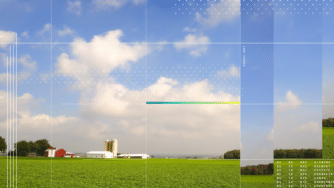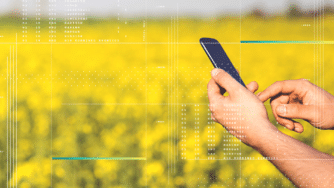by Margaret Kosmala and Eli Schwat
Nitrogen is a crucial element in farming, but calculating just how much to add to a field is a complicated process with many variables, besides the obvious question how much does nitrogen cost? The stakes are high: add too much fertilizer, and it can leach into the groundwater and create serious environmental and health problems (plus it costs money). On the other hand, a farmer who applies too little fertilizer is likely to see a lower yield, thereby a lower profit.
 Figure 1: Average nitrogen applied across the corn belt (pounds per acre)
Figure 1: Average nitrogen applied across the corn belt (pounds per acre)
Because it is so difficult to calculate, farmers have often turned to university extension services or fertilizer companies for advice on how much fertilizer to apply to their fields. While backed by research, these recommendations about the nitrogen cycle are broad and apply to general geographic regions rather than being specific to individual fields. However, today’s computing power and high-resolution geographic data mean it’s possible to quantify both the effects of nitrogen on separate farms, as well as understand trends and patterns in nitrogen application across the U.S.
CIBO’s data system can reveal the structure and functioning of individual parcels of land, providing insight into a property’s economic value while also helping its owner increase the land’s sustainability. If we consider two hypothetical landowners and how they might work on their land, we can see the many options farmers must weigh in deciding how much nitrogen to apply to their fields. While nitrogen is important for crop growth, we will also look at the environmental and health effects of nitrogen leaching resulting from nitrogen application.
The Variables a Farmer Must Weigh
Consider the case of Jake, a farmer in Winneshiek County, Iowa. One of Jake’s fields is 33 acres, and he has been using a corn-soy rotation. This year, he planted corn and he wants to know how much nitrogen to add. Jake could consult the local agricultural extension service, as he has done in the past. But he also remembers that he applied 177 pounds per acre of fertilizer the last time he grew corn, and that produced a good yield. So he decides to apply 177 pounds per acre again.
 Figure 2: Jake’s field in Winneshiek County, Iowa
Figure 2: Jake’s field in Winneshiek County, Iowa
Example A
As he calculates his income for his 33-acre field, Jake first considers what would happen if he doesn’t fertilize at all for comparison:
- 122 bushels per acre: Jake’s total yield of corn
- $3.70/bushel: Amount Jake can charge for his corn
- $14,896: Total income from the field
Example B
Next, Jake calculates the income from the 33-acre field if he applies his standard rate of fertilizer:
- 177 pounds per acre: Amount of fertilizer he needs (based on a previous year’s usage)
- 5,841 pounds: Total amount of fertilizer he will need to apply
- $1,402: Total cost of fertilizer
- 162 bushels per acre: Jake’s total yield of corn
- $3.70/bushel: Amount Jake charges
- $19,780: Gross income from the sale of corn
- $18,378: Net income from the field after subtracting for the cost of fertilizer
Total income difference between applying fertilizer and not applying it: +$3,482
So it seems like a no-brainer that Jake should use fertilizer. But there are other vital elements Jake might consider, as well.
The Environmental Costs of Applying Fertilizer
The interconnectedness between agriculture and the environment means that what Jake does on his farm affects not only his own family but also his local community and beyond. Any extra nitrogen that Jake applies that is not taken up by corn plants leaches out of the soil into groundwater and is transformed by soil into gases. Nitrogen leaches out of soil as nitrate, which can have a highly negative effect on the local environment and our health: high levels of nitrates can poison well water, leading to the potentially fatal “blue baby” syndrome in infants.
Also, excess fertilizer nitrogen can be transformed by the soil into nitrous oxide, a powerful greenhouse gas. And transformed nitrogen can enter the air as ammonia and then be redeposited in lakes and streams, which dramatically decreases water quality. These environmental impacts of Jake’s choices are felt by his neighbors and local community, as well as people all around the world who are connected by the same atmosphere.
In addition to our previous calculations, let’s factor in one of the environmental effects — nitrogen leaching. Using a crop simulator, we can calculate the amount of nitrogen that leaches into groundwater when no fertilizer is applied.
In Jake’s field, 6 pounds of nitrogen per acre leach into groundwater when he adds no fertilizer (as in Example A — remember there is already nitrogen in the soil from previous years of farming). When Jake adds 177 pounds of fertilizer (Example B), we find that the field leaches 38 pounds of nitrogen per acre into the groundwater. If the social cost of nitrogen is $1.19 per pound of applied nitrogen, then we find that the cost to society of Jake fertilizing his field is $6,951. As part of society, we might wonder: could Jake use less fertilizer, reducing his environmental impact, and still achieve his yield and profit goals?
To get a more accurate idea of Jake’s ideal fertilizer usage (and also determine if he can apply less of it), let’s use CIBO’s proprietary software. The technology incorporates remote sensing, artificial intelligence, crop growth simulation, and old-fashioned farm knowledge to analyze the land and determine ideal practices. CIBO uses algorithms that consider how soils, weather, and management practices such as crop rotations and tillage systems affect the nitrogen that is added to a field. Using this simulation software, we can calculate the effects of changing fertilizer practices at a specific location without taking the time and effort of having to go out and do experiments in the field.
We’ll run the numbers with 132 pounds of fertilizer, a 25% reduction compared to Example B.
Example C
- 132 pounds per acre: Amount of fertilizer Jake applies to the field
- 4,356 pounds: Total amount of fertilizer he will need
- $1,046: Total cost of fertilizer
- 162 bushels per acre: Jake’s total yield of corn
- $3.70/bushel: Amount Jake can charge
- $19,780: Gross income from the sale of corn
- $18,734: Net income from the field after subtracting for the cost of fertilizer
- $5,184: Societal cost to the environment
In addition to an increased profit of $356 compared to Example B, the amount of nitrogen leaching into groundwater decreases from 38 pounds per acre to 32 for an accompanying environmental impact savings of $1,767. This is a win-win.
A Different Farm a Few Miles Away
It’s important to incorporate local conditions and weather into simulations because not all fields will respond the same way to changes in management practices. Jake’s friend Jenn has a 24-acre farm in another part of Winneshiek County. She is also growing corn and considering how much nitrogen fertilizer to add.
If we simulate her field the same way we did Jake’s, we find that Jenn will get very different results if she decreases the amount of fertilizer she applies. In our standard example, Jenn applies her usual 177 pounds of nitrogen fertilizer, the same rate Jake uses.
 Figure 3: Jenn’s field in Winneshiek County, Iowa
Figure 3: Jenn’s field in Winneshiek County, Iowa
Example D
- 177 pounds per acre: Amount of fertilizer Jenn applies to the field
- 4,248 pounds: Total amount of fertilizer she will need
- $1,020: Total cost of fertilizer
- 149 bushels per acre: Jenn’s total yield of corn
- $3.70/bushel: Amount Jenn can charge
- $13,231: Gross income from the sale of corn
- $12,211: Net income from the field after subtracting for the cost of fertilizer
- $5,055: Societal cost to the environment
For Jenn’s standard scenario, her net income is $12,211, and her environmental impact is $5,055.
Now we’ll calculate what happens if she reduces fertilizer application by 25%.
Example E
- 132 pounds per acre: Amount of fertilizer Jenn applies to the field
- 3,168 pounds: Total amount of fertilizer she will need
- $760: Total cost of fertilizer
- 113 bushels per acre: Jenn’s total yield of corn
- $3.70/bushel: Amount Jenn can charge
- $10,034: Gross income from the sale of corn
- $9,274: Net income from the field after subtracting for the cost of fertilizer
- $3,770: Societal cost to the environment
If Jenn reduces fertilizer application by 25%, we see a reduction in the environmental impact, just like with Jake’s farm, at a savings of $1,285 to society. However, unlike Jake’s farm, Jenn’s yield is substantially reduced with lower nitrogen input — from 149 to 113 bushels per acre, and she sees a loss of $2,937 in net income.
So, even though Jake and Jenn farm in the same county and are using the same amount of nitrogen, and even though it would benefit the environment for both to reduce their fertilizer usage, the economics between the two farms are very different. Jake would benefit from reducing fertilizer use, whereas Jenn would lose money if she did so.
No Substitute for Thorough Nitrogen Analysis
These scenarios illustrate the importance of in-depth land research. It is well known that increasing nitrogen fertilizer increases yields, but only up to a point. Once that optimal amount of fertilizer is reached, yields will stabilize and not increase any further, even if additional fertilizer is applied. That extra fertilizer is essentially wasted.
In fact, the optimal amount of fertilizer to apply is slightly less than the amount of fertilizer that maximizes yield. This is because fertilizer’s effect on yield gets smaller and smaller as the yield gets closer to its maximum. So the income from the additional yield is less than the cost of the additional fertilizer. The economic balance between fertilizer and yield depends on the cost of fertilizer and corn, so it varies from year to year.
Obviously, these sorts of decisions about farm management practices are of great importance to farmers. But they should be relevant to the rest of us, too. We have just examined small farm fields here, but the implications of small-scale decisions like those of Jake and Jenn are widely felt at the regional and national levels. Consider that more than 90 million acres of the continental United States — 4% of its total area — is planted to corn each year. If the average amount of applied nitrogen is 150 pounds per acre, the national cost to society due to the environmental impact of nitrogen application in corn production is over $16 billion.
For policymakers and their advisors, the challenge is that there is no one-size-fits-all solution to environmental problems. As we have seen, we can’t simply advise Jake and Jenn to change their behavior. Jake has an inherent economic incentive to do so, but Jenn does not. Policymakers could increase environmental regulation, but the effects would be economically damaging to some farmers like Jenn.
A tailored approach using incentives might be more effective if they could take into account the differences in farmland at the field level. Simulation software could help identify which areas are particularly prone to nitrogen leaching, so that specific policies could target those regions. Or a more customized methodology could determine where a reduction in nitrogen fertilizer application would have little effect on yields.
Conclusion
Farmland in the United States is a complex patchwork. Existing policies, regulations, and recommended management practices paint broad brushstrokes across varying geographic areas. However, we now have the data and computing power to allow us to think about U.S. farmland with greater nuance. We should leverage all the knowledge we have about crop growth, soils, hydrology, weather, environmental sensitivity, and farm economics to create policies and norms that help farmers and protect the environment.
CIBO’s proprietary data-analysis tools enable us to analyze land information at the most granular level and understand the effects of farming the land. With just a few clicks, CIBO can open up a world of insight that was nearly impossible to find before.
About the Authors
Margaret Kosmala
Margaret Kosmala is a Data Scientist at CIBO, a science-driven software startup. Prior to CIBO, she was a postdoctoral fellow at Harvard University and a predoctoral fellow at the Smithsonian Institution’s National Museum of Natural History. She holds a Ph.D. in Ecology from the University of Minnesota and a Bachelor of Science in Computer Science from Brown University.
Eli Schwat
Eli Schwat is a Software Engineer at CIBO, a science-driven software startup. He holds a B.A. in Environmental Sciences from Vanderbilt University.



